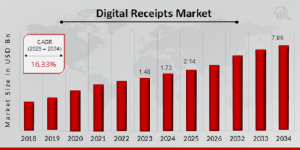Digital Receipts Market Predicted to Hit 7.86 Billion by 2034
Digital Receipts Market thrives on mobile payments, sustainability, and AI-driven personalization, enhancing customer experience and operational efficiency
The digital receipts market is gaining substantial traction as businesses and consumers increasingly shift toward paperless transactions in a rapidly evolving digital economy. Digital receipts, also known as e-receipts, are electronic versions of traditional paper receipts that are sent to customers via email, SMS, or app notifications after a purchase. This growing trend is driven by the rise of e-commerce, advancements in point-of-sale (POS) systems, and the increasing adoption of mobile and digital payment methods. As companies seek to streamline operations, reduce paper usage, and enhance customer engagement, digital receipts provide a cost-effective and eco-friendly alternative to traditional receipts. Additionally, the widespread emphasis on sustainability and digital transformation across industries is further accelerating the demand for digital receipt solutions. With the ability to integrate with customer relationship management (CRM) systems, digital receipts also offer valuable opportunities for data-driven marketing, customer insights, and loyalty program enhancements, making them an essential component of modern retail and financial ecosystems.
Download Sample Pages: https://www.marketresearchfuture.com/sample_request/31769
Market Segmentation:
The digital receipts market can be segmented by type, application, deployment mode, end-user, and region. By type, the market includes email receipts, SMS receipts, and app-based receipts, with email receipts currently accounting for the largest share due to their universal accessibility and ease of storage. In terms of application, digital receipts are widely used across retail, hospitality, banking, healthcare, and e-commerce sectors, with retail and e-commerce showing the most significant adoption due to the high volume of transactions and customer interaction. Based on deployment mode, the market is categorized into cloud-based and on-premise solutions, where cloud-based systems dominate owing to their scalability, flexibility, and cost-efficiency. End-users include large enterprises and small and medium-sized enterprises (SMEs), both of which are leveraging digital receipt solutions to enhance customer experience and ensure compliance with electronic documentation standards. Geographically, the market spans North America, Europe, Asia-Pacific, Latin America, and the Middle East & Africa, each contributing uniquely to market dynamics based on technology adoption rates and regulatory environments.
Market Key Players:
Key players in the digital receipts market are focusing on innovation, strategic partnerships, and expansion to gain a competitive edge in this rapidly evolving space. Leading companies such as:
• Invoice2go
• Toast
• Expensify
• GoCardless
• Zapper
• SumUp
• Revel Systems
• Kabbage
• Greenback
• Shopify
• Yelp
• QuickBooks
• PayPal
• Scanpay
• Square
Browse In-depth Market Research Reports On Digital Receipts Market: https://www.marketresearchfuture.com/reports/digital-receipts-market-31769
Market Opportunities:
The digital receipts market presents a wide range of opportunities, especially as the global shift towards digitization and sustainable practices gains momentum. One of the most significant opportunities lies in leveraging digital receipts for targeted marketing and personalized customer experiences. With every transaction, businesses can collect valuable data on consumer behavior, preferences, and purchase history, which can be used to send tailored promotions and drive repeat business. The growing penetration of smartphones and internet connectivity in emerging economies opens up substantial market potential for digital receipt providers. Furthermore, integration with digital wallets, mobile banking apps, and loyalty platforms provides additional touchpoints for consumer engagement. Governments and financial institutions promoting electronic documentation and digital finance initiatives are also expected to boost market growth. Expansion into underpenetrated sectors such as healthcare, logistics, and utilities, where documentation and customer interaction are vital, can unlock new revenue streams for digital receipt vendors.
Restraints and Challenges:
Despite the promising outlook, the digital receipts market faces several challenges that could impact its growth trajectory. One of the primary concerns is data privacy and security, as digital receipts involve the collection and storage of sensitive customer information. Companies must ensure compliance with data protection regulations such as GDPR, CCPA, and other regional laws to build trust and avoid legal penalties. Another challenge is the resistance from both consumers and small businesses who may prefer traditional paper receipts due to habit or technological limitations. Integration with legacy POS systems, especially in developing markets, can also be complex and costly. Additionally, inconsistent internet access and limited digital literacy in certain regions can hinder the adoption of digital receipt solutions. Addressing these challenges will require continuous innovation, robust data protection measures, and extensive user education to promote the benefits of digital receipts and ensure a seamless transition from paper to digital.
Procure Complete Research Report Now: https://www.marketresearchfuture.com/checkout?currency=one_user-USD&report_id=31769
Regional Analysis:
Regionally, North America holds a dominant position in the digital receipts market, driven by widespread adoption of digital payment systems, high smartphone penetration, and strong regulatory support for paperless transactions. The United States, in particular, is leading the way with large-scale deployment of cloud-based POS systems and growing demand for integrated customer engagement solutions. Europe follows closely, with countries like the United Kingdom, Germany, and France embracing digital receipts as part of their broader sustainability goals and digital transformation initiatives. The Asia-Pacific region is poised for rapid growth due to the expansion of the e-commerce industry, government-led digitization efforts, and the increasing adoption of mobile wallets in countries such as China, India, and Japan. Latin America and the Middle East & Africa are also emerging markets for digital receipts, driven by improved internet infrastructure, rising smartphone usage, and increasing awareness of digital finance. Each region presents unique opportunities and challenges, making localized strategies essential for sustained market penetration and growth.
Recent Developments:
Recent developments in the digital receipts market reflect a growing emphasis on enhancing functionality, user experience, and data utilization. Companies are increasingly incorporating advanced analytics, artificial intelligence, and automation to create intelligent digital receipt solutions that go beyond basic transaction records. For instance, AI-powered receipts can now include dynamic recommendations, interactive content, and links to digital loyalty programs. Partnerships between fintech companies and retailers are enabling seamless integration of digital receipts into existing financial apps, offering users a unified view of their spending and budgeting. Cloud service providers are also playing a critical role by offering scalable and secure infrastructure to support digital receipt management at scale. In response to increasing regulatory requirements, vendors are enhancing encryption and data privacy features to ensure compliance and customer trust. As environmental concerns and customer expectations continue to evolve, the digital receipts market is expected to see sustained innovation and growth, becoming a key component of digital commerce and consumer engagement strategies worldwide.
Related Reports
Cellular Interception Market;
https://www.marketresearchfuture.com/reports/cellular-interception-market-27398
Cloud Based Business Analytics Software Market;
https://www.marketresearchfuture.com/reports/cloud-based-business-analytics-software-market-27380
Automatic Speech Recognition (ASR) Software Market;
https://www.marketresearchfuture.com/reports/automatic-speech-recognition-asr-software-market-27251
Mips Bicycle Helmets Market;
https://www.marketresearchfuture.com/reports/mips-bicycle-helmets-market-27713
Mobile Card Reader Market;
https://www.marketresearchfuture.com/reports/mobile-card-reader-market-27705
Rising Urban Infrastructure and Smart Home Integration Propel Domestic Booster Pumps Market to USD 6.6 billion by 2035
John O’Farrell Partners with SuccessBooks® to Co-Author 'Flip the Script' with Chris Voss
Galatea Bio joins iHope Genetic Health Program, Expanding Access to Genomic Testing for Underserved Families
Kalendarium
Więcej ważnych informacji
 Jedynka Newserii
Jedynka Newserii

 Jedynka Newserii
Jedynka Newserii

Prawo

Kwestie bezpieczeństwa priorytetem UE. Polska prezydencja ma w tym swój udział
– Polska prezydencja skierowała oczy Europy na obronność – przekonuje Magdalena Sobkowiak-Czarnecka z KPRM. Większość europejskich państw jest zgodna, że najważniejszą kwestią jest obecnie finansowanie bezpieczeństwa i obronności. Jednym z priorytetów białej księgi w sprawie obronności europejskiej będzie Tarcza Wschód, która obejmuje umocnienia wzdłuż wschodniej i północnej granicy Polski.
Problemy społeczne
Duża zmiana w organizacji pracy w firmach. Elastyczność wśród najważniejszych oczekiwań pracowników

Dotychczasowe modele organizacji pracy w firmach nie zawsze odpowiadają na wyzwania przyszłości. Ostatnie lata zmieniły zasady gry na rynku pracy i teraz elastyczność liczy się na nim bardziej niż kiedykolwiek wcześniej. Elastyczny model pracy staje się jednym z bardziej oczekiwanych benefitów, a dla firm jest to sposób na przyciągnięcie talentów. Kolejnym jest wykorzystanie innowacyjnych narzędzi technologicznych. To jednak wymaga zarówno od pracowników, jak i od pracodawców zaangażowania w ciągłe podnoszenie kompetencji.
Motoryzacja
Pożary pojazdów elektrycznych są rzadsze niż spalinowych. W powszechnym przekonaniu jest odwrotnie, bo brakuje edukacji

Trzydzieści pożarów aut elektrycznych i niemal 9,5 tys. pożarów aut spalinowych – to statystyki za ubiegły rok. Jak podkreślają eksperci, statystycznie pojazdy elektryczne płoną rzadziej niż spalinowe. W przeliczeniu na tysiąc zarejestrowanych pojazdów wskaźnik pożarów w przypadku elektryków wynosi 0,372, a w przypadku aut spalinowych 0,424. Specjaliści są zgodni co do tego, że w powszechnym obiegu brakuje rzetelnej wiedzy na temat samochodów elektrycznych i ich bezpieczeństwa pożarowego.
Partner serwisu
Szkolenia

Akademia Newserii
Akademia Newserii to projekt, w ramach którego najlepsi polscy dziennikarze biznesowi, giełdowi oraz lifestylowi, a także szkoleniowcy z wieloletnim doświadczeniem dzielą się swoją wiedzą nt. pracy z mediami.




![Dramatyczna sytuacja w opiece długoterminowej. Kolejki oczekujących są coraz dłuższe [DEPESZA]](https://www.newseria.pl/files/1097841585/opieka-nfz-still-1,w_85,_small.jpg)



.gif)

 |
| |
| |
|